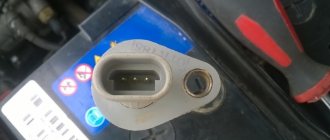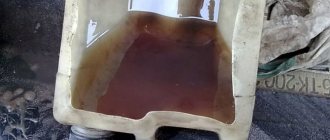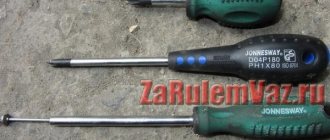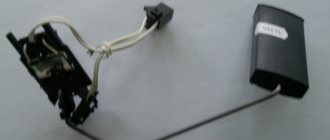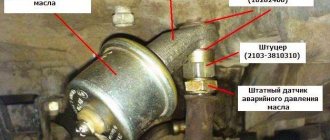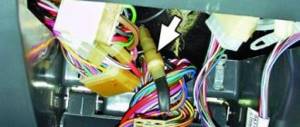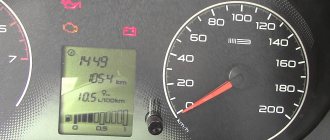The mass air flow sensor is used to regulate the amount of air flow entering the engine and necessary to form the combustible mixture. Many car owners often complain about this regulator, since in practice it can fail quite quickly. Accordingly, our compatriots are increasingly installing DBP and DTV instead of DMRV. You can learn more about what is needed for this and how to carry out the replacement procedure from this material.
[Hide]
Advantages and disadvantages of absolute pressure and air temperature sensor
Graph of air flow versus voltage
First, let's determine what advantages absolute pressure and air temperature sensors have over traditional flow meters. These advantages and disadvantages will allow you to determine what is best to install on your car and whether it makes sense.
So, let's start with the advantages:
- The first advantage is the cost of the sensors. For example, for VAZ cars the cost of a mass flow sensor is about three thousand rubles. While DBP and DTV can be purchased in total for about 1,600 rubles.
- Service life. Problems often occur in the operation of mass air flow sensors - the device fails due to being clogged with dirt, and the sensitive element of the regulator may also wear out. If the mechanism becomes clogged, then, in principle, it can be cleaned, but if the problem lies precisely in the sensitive component, then it is unlikely to be replaced. In any case, the service life of flow meters is always limited. If we take into account temperature and absolute pressure regulators, they are usually installed for the entire life of the vehicle.
- Installing two regulators instead of one flow meter, as practice shows, allows for smooth idling on camshafts with the so-called “evil” phase, from 290 degrees and above.
- Excellent responsiveness of the gas pedal when pressed. Car owners who have already switched from mass air flow sensors to regulators note that such a system works faster, without “brakes”.
- More optimal operation of the power unit after replacement. A correctly installed system quickly calculates the required volume of air flow, accordingly, this will lead to the engine crankshaft spinning much faster. As a result, the power unit will produce higher power.
- Many car owners, after installing DAT and DTV instead of a flow meter, note that at idle speed the power unit operates much quieter. However, this advantage should not be taken as mandatory, since it depends on the efficiency of the engine, as well as its design features.
- Installation of such a system is possible on turbocharged engines.
Screenshot of the control unit settings during flashing
These are the main advantages of switching from flow meters to DAT and DTV.
Despite all the advantages, such systems also have certain disadvantages:
- In cars with factory firmware it will not be possible to install such a system. To implement it you will need special sports firmware.
- Installing such a system is quite a complicated task, and not every car enthusiast can cope with it. If you belong to the category of car owners who can only fill the expansion tank with washer fluid or change the engine oil, then it is better not to take on this task. If you make mistakes (and without knowledge you will certainly make them), this will lead to a deterioration in engine performance. You will not be able to experience all the benefits of installing DAT and DTV, plus, you will throw away money on the implementation of this scheme.
- Another point why you shouldn’t take on this activity without specialists is the need to understand the firmware. And not just look at the main parameters or find out the version, but also work with the firmware, changing the values and adjusting the system to your needs. At the very least, you will need a qualified professional to perform this task.
- Such systems actually do not meet modern toxicity standards. With a big stretch, according to toxicity standards, they can be classified as Euro 3 (the author of the video is the Lty D channel).
How to change the air flow sensor of a LADA “Granta”
The mass air flow sensor cannot be repaired and if it malfunctions, it must be replaced with a new one. Replacing the MAF sensor of the LADA “Granta” is performed as follows:
- Unscrew the clamp with a screwdriver;
- disconnect the connector from the mass air flow sensor;
- Using a 10mm wrench, unscrew the two MAF mounting bolts;
- pull out the sensor with the seal from the air filter housing;
- install a new sensor with an o-ring;
- screw in and tighten the sensor mounting bolts;
- connect the connector.
The MAF sensor has been replaced; all that remains is to check its operation by performing a test start of the engine and a drive.
Pros and cons of the mass air flow sensor
DMRV has very few advantages:
- The device allows you to accurately determine the volume of air flow to form the air-fuel mixture. With the MAF installed, the vehicle can be fully operated.
- If the regulator fails, it can be easily replaced with a new one. If it becomes clogged, then, if necessary, you can simply clean it, which will allow you to resume its further operation. Cleaning, by the way, can be done using carburetor cleaner, which can be found in any car shop.
These regulators have no more advantages, but they have much more disadvantages:
- Short service life. Over time, the flow meter will begin to “dull” in any case.
- High price. As stated above, the price of the flow meter is unreasonably high, especially considering its not particularly long service life and the need for periodic maintenance.
- Such devices are not suitable for installation on cars equipped with turbocharged engines.
- As many car enthusiasts note, such flow meters work very slowly. In order for the sensor to be able to properly read the volume of air flow, it requires quite a lot of time, and accordingly, this leads to the fact that the vehicle operates less dynamically.
- On camshafts with an evil phase, the idle will be floating or at least uneven. This, in turn, will affect the performance of the power unit as a whole.
Simple controller connection diagram
Design and principle of operation of the LADA Granta mass air flow sensor
The purpose of the mass air flow sensor is to control the amount of air flowing from the air filter into the engine. The LADA Granta mass air flow sensor is installed on the pipe between the throttle valve and the filter and measures the flow speed in a simple and original way: by monitoring the cooling of the electrical conductor. The mass air flow sensor has two platinum filaments through which current passes. The first thread is cooled by the air flow passing from the filter, the second is a control thread. By cooling the first thread, the resistance decreases in proportion to the strength of the air flow. Accordingly, the engine ECU receives information about the amount of incoming air and can ensure the optimal ratio of the components of the air-fuel mixture supplied to the combustion chambers.
Instructions for replacing controllers
Let's consider the replacement procedure using VAZ cars as an example. To implement this system, it is important to take into account the requirement for the control unit - it must be version January 5.1 or January 7.2. The second option is more preferable, since you can find free firmware for it, on the basis of which you can make DBP. Versions January 5, as well as Bosch ECUs, are not suitable for this, since they will not be able to function with DBP.
Required tools and materials
To make the transition from mass air flow sensor to DBP, you will need the following elements:
- directly the DBP itself, you can use Gazelevsky (45.3829) or from Volkswagen (Siemens SME 5WK96930-R);
- you will also need DTV, you can use it from Niva, Daewoo Nexia, or take DTOZH for VAZ cars (you will have to modify it a little);
- to install DBP you will need a speed sensor plug;
- To connect the DTV you will need a DTOZH plug.
Photo gallery “Getting ready for installation”
1. DBP Siemens SME 5WK96930-R
2. DTV for Daewoo Nexia
3. Speed sensor connector
4. DTOZH for VAZ cars
Installation and connection
For the system to work well, you need to install all the elements correctly:
- The DAT is mounted on the engine panel, since it is very sensitive to vibrations. The controller should be installed with the plug down, this will prevent the accumulation of moisture and condensation inside. The device is connected to the gasoline pressure regulator pipe through a special tee; alternatively, it can be connected to the receiver.
- The DTV can be installed in the housing of the air filter element, in the pipe next to it, or in the flow meter housing. Securely fix the sensor so that it does not become loose due to engine vibrations.
- To connect the devices, you will need to run wires from the electronic control unit to the controllers; the wires themselves can be laid through a special hole next to the vacuum brake booster. As for the connection order, for DTV it is not particularly important, but in the case of DAT it is necessary to take into account the pinout, it is marked on the body of the device.
- Once the devices are installed and connected, it is necessary to flash the control unit, since different parameters will be used to operate these sensors. In the case of VAZ cars, you can use firmware J5LS (J5 Light Sport), J5SPT0005. As stated above, the flashing procedure is a rather difficult and responsible task, so you need to be prepared for this step. If you have doubts that you can do everything correctly, then it is better to entrust this task to specialists.
Loading …
Testing and diagnostic methods
Shutdown
Pulling out the sensor is fairly easy. It is located in the air filter.
Article on the topic: Short-stroke rocker for VAZ 2110: installation, replacement of the cardan
This method involves starting the motor with the sensor removed - we need to disconnect its connector. When turned off, the controller starts emergency mode, and new portions of the mixture are calculated based on the position of the damper. We need to drive a little, the speed should be above 1500 rpm. If the car behaves more dynamically without a mass air flow sensor, then the diagnosis is complete - it’s time to change the consumable.
Checking with a multimeter
This test requires that you have skills in using a multimeter (tester). The method is suitable for almost all VAZ models, including 2110. We need to take a multimeter and set it to a mode that measures constant voltage, which is usually designated DCV or only V. To work with the mass air flow sensor, you need to understand its pinout, it is as follows:
- Yellow, closest to the windshield, supplies current to the signal input;
- Green indicates ground;
- The pink or red-black wire comes from the main relay;
- The white-gray wire is responsible for the voltage output.
The location of the wires and their sequence.
Depending on the model, the colors may be different, but the location does not change. Here you will have to deal with a specific model. But once you find the input signal wiring (closer to the windshield) and grounding, you can do it without instructions. The wiring is clear, now you need to turn on the ignition without starting the engine. The tester sets a limit of 2 Volts. The black probe of the tester is connected to the green ground wire of the air flow sensor, and the red one is connected to the yellow one. The measurement takes place between two terminals. The probes must be inserted carefully; an additional needle is not required, since the probes can be freely inserted along the wires without damaging the insulation.
We look at the tester display. If the consumable is new, then there we will see a voltage indicator of 1.01. Over time, the indicator increases as the resistors wear out (the resistance drops). The larger the number, the greater the wear of the sensitive element:
- In good condition, the indicator will be 1.01… 1.02;
- With “normal” - 1.02... 1.03;
- The sensor will soon stop working – 1.03… 1.04;
- The dying state of the flow meter is accompanied by an indicator of 1.04… 1.05;
- Replacement of the unit is required when the reading is 1.05 or higher.
Testing the mass flow sensor. The dipstick must be inserted carefully.
Diagnostics can also be carried out without a multimeter. Instead, you can use the on-board computer. To do this, you need to go to the “voltage from the mass flow sensor” section; we are interested in the “U MAF” indicator.
Visual inspection
Here we need to carefully examine the surface of the corrugation and consumables. To check the condition, we need to loosen the air intake clamp at the outlet of the mass air flow sensor, and then pull it off. If you see traces of grease or condensation on the surface, then most likely they have damaged the unit. Sometimes the sensor can be “reanimated” by removing all the dirt. It ends up in the consumables due to rare changes of the air filter. If liquid appears on the sensitive element, this is a 90% failure. Lubricating oil enters due to a clogged oil separator or due to an increased level in the crankcase.
Article on the topic: How to connect the State on-board computer to a VAZ 2110 (instructions)
Drops of oil on the sensor are a sure sign that it has failed.
If the above-described elements are detected, the diagnosis can be completed. If the surface is clean, move on. Remove the consumable from the air filter. It is held in place only by 2 screws, which are unscrewed with the 10th key. Looking at the photo, we see that there is an o-ring on the front of the mass flow sensor. It is installed for sealing - unfiltered air cannot leak through the inlet.
If this ring (in the photo it is green, but your color may be different) has slipped or remains in the filter housing, then a layer of dust can be found on the consumable mesh. Such a defect is enough to cause the sensitive element to fail. You need to assemble the unit according to the following scheme: check the reliability of the sealing skirt, put on the rubber ring, place the sensor in the air filter housing.
